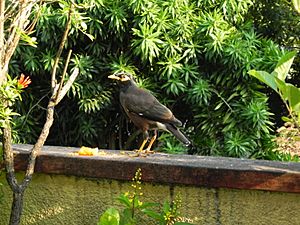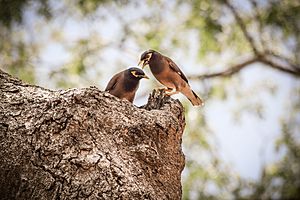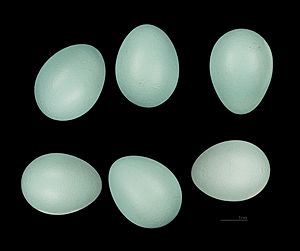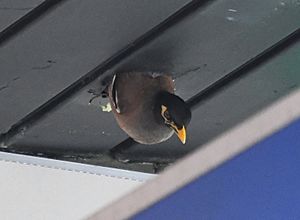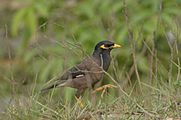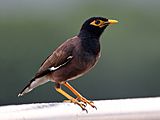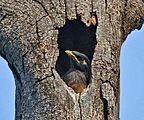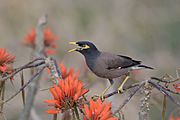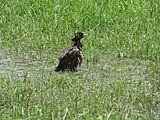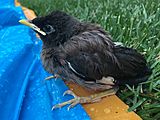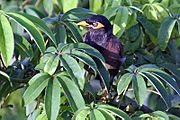Common myna facts for kids
Quick facts for kids Common myna |
|
|---|---|
 |
|
| A common myna in Kokrebellur, India | |
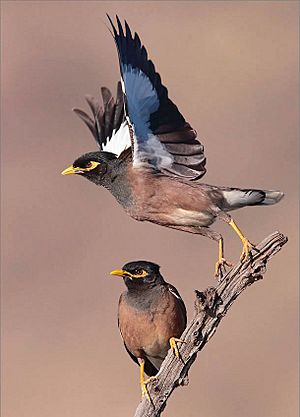 |
|
| Conservation status | |
| Scientific classification | |
| Genus: |
Acridotheres
|
| Species: |
tristis
|
| Subspecies | |
|
Acridotheres tristis melanosternus |
|
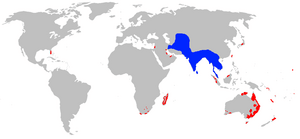 |
|
| Where the common myna lives. Blue shows its native home, red shows where it was introduced. | |
| Synonyms | |
|
Paradisaea tristis Linnaeus, 1766 |
|
The common myna or Indian myna (Acridotheres tristis) is a bird from Asia. It belongs to the starling family. This bird lives in open woodlands and is very territorial. It has learned to live very well in cities and towns.
The common myna's home range is growing quickly. In 2000, a group called the IUCN said it was one of the world's worst invasive species. It is one of only three birds on a list of "100 of the World's Worst Invasive Species." These birds threaten nature, farms, and human interests. In Australia, it is even called "The Most Important Pest/Problem."
Contents
About the Common Myna
How Scientists Name Them
In 1766, a Swedish scientist named Carl Linnaeus gave the common myna its scientific name, Paradisea tristis. Later, scientists changed its name to Acridotheres tristis. The word tristis means "sad" or "gloomy" in Latin.
There are two main types, or subspecies, of common mynas:
- The Indian myna (A. t. tristis) lives from Kazakhstan and Iran to China, India, and Malaysia.
- The Sri Lankan myna (A. t. melanosternus) lives in Sri Lanka. This type is darker and has a larger yellow patch on its cheek.
What They Look Like
The common myna is easy to spot. It has a brown body and a black head that looks like a hood. There is a bright yellow patch of skin behind its eye. Its beak and legs are also bright yellow. When it flies, you can see a white patch on its outer wing feathers. Male and female mynas look similar. They are usually seen in pairs.
What They Sound Like
Common mynas make many different sounds. These include croaks, squawks, chirps, clicks, whistles, and growls. When they sing, they often fluff their feathers and bob their heads. They screech to warn other birds if a predator is nearby. They also make warning calls when they are about to fly away. People sometimes keep common mynas as pets because they can sing and even "speak." Before they sleep in groups, many mynas call out together. This is known as "communal noise."
Size and Weight
A common myna is about 23 centimeters (9 inches) long.
- Males usually weigh around 110 grams.
- Females usually weigh between 120 and 138 grams.
Where They Live and Their Homes
The common myna is originally from Asia. Its native home stretches from Iran to India, China, and Malaysia.
This bird has been introduced to many other parts of the world. These places include Canada, Australia, New Zealand, the United States, and South Africa. Its range is growing so much that in 2000, the IUCN called it one of the world's 100 worst invasive species.
These birds are very common in open woodlands, farms, and near human homes. They are very good at adapting to new places. In Singapore, they are even called a pest because they compete with another type of myna.
Common mynas do very well in cities and suburbs. For example, in Canberra, Australia, 110 mynas were released between 1968 and 1971. By 1991, there were about 15 mynas per square kilometer. Just three years later, there were 75 mynas per square kilometer in the same area! They like cities because they are used to open woodlands with tall structures, like trees. City streets and parks have similar features.
Common mynas can be a problem for city buildings. Their nests can block gutters and drainpipes. This can cause water damage to the outside of buildings.
How They Behave
Breeding and Nests
Common mynas are thought to stay with the same partner for their whole lives. They can breed almost all year, depending on where they live. They build their nests in holes in trees or walls. They can nest from sea level up to 3,000 meters high in the Himalayas.
A female myna usually lays 4 to 6 eggs. The eggs are about 30.8 by 21.99 millimeters in size. The eggs hatch after 17 to 18 days. The young birds leave the nest after 22 to 24 days. Sometimes, another bird called the Asian koel lays its eggs in a myna's nest. Mynas use twigs, roots, and even trash to build their nests. They have been seen using tissue paper, tin foil, and even snake skin!
Common mynas often use nests made by other birds like woodpeckers. They also like to use nest boxes. They are known to be very aggressive. They might even throw out the chicks of other birds from their nests. This aggressive behavior helps them succeed as an invasive species. In new places, they often choose to nest in human-made structures rather than natural tree holes.
What They Eat
Like most starlings, common mynas eat many different things. They are omnivorous. They eat insects, spiders, crabs, reptiles, small mammals, seeds, grains, and fruits. They also eat discarded food from humans. They look for insects on the ground, especially grasshoppers. This is why their scientific name, Acridotheres, means "grasshopper hunter." They also help pollinate flowers like Salmalia. They walk on the ground and sometimes hop. They are good at finding insects that are disturbed by grazing cattle or by fires in grassy fields.
Sleeping in Groups
Common mynas sleep together in large groups all year round. These groups can be made up of only mynas or a mix of different birds. The number of birds in a group can range from less than a hundred to thousands. Mynas start arriving at their sleeping spots before sunset and leave before sunrise.
Sleeping in groups helps them with many things. It helps them do social activities together. It also helps them avoid predators and share information about where to find food. Before and after sleeping, mynas often fly together in the air. This happens during the breeding season and might be related to finding a mate.
An Invasive Species
The IUCN has named the common myna as one of the world's 100 worst invasive species. Only two other birds are on this list.
In the 1700s, the French brought common mynas from India to Mauritius. They wanted the birds to control insects. Since then, mynas have been introduced to many other places. These include Madagascar, the Middle East, South Africa, the United States, Australia, New Zealand, and many islands.
The common myna is seen as a pest in many of these places. It is a big problem in Australia. People have tried different ways to control their numbers and protect native birds.
In Australia
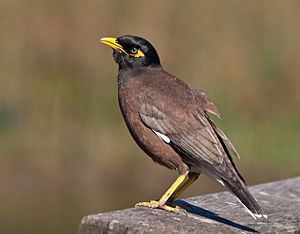
In Australia, the common myna is a serious invasive pest. They are now often the most common bird in cities along the East Coast. In 2008, people voted the common myna "The Most Important Pest/Problem" in Australia. They even call them "flying rats" because they scavenge for food like rats. Some also call them "the cane toad of the sky."
Common mynas were first brought to Australia in Victoria between 1863 and 1872. They were meant to control insects in gardens. They likely spread to New South Wales around the same time. Later, they were brought to Queensland to eat grasshoppers and cane beetles. Today, most common mynas in Australia live along the eastern coast, especially around Sydney.
These birds can live and breed in many different temperatures. This includes the cold winters of Canberra and the warm climate of Cairns. This means they could spread to many more parts of Australia.
In Europe
In 2019, common mynas were added to a list of invasive alien species that are a concern for the European Union. They have settled in Spain and Portugal. They were also brought to France, where they sometimes breed.
In New Zealand
Common mynas were brought to both the North and South Islands of New Zealand in the 1870s. However, the cooler summers in the South Island made it hard for them to breed. So, they mostly disappeared there by the 1890s. But in the North Island, they bred more successfully. Now, large parts of the North Island have many mynas.
In South Africa
In South Africa, common mynas escaped into the wild in 1902. They have become very common, especially where there are more people or human activity. These birds are known for being a pest. They kick other birds out of their nests and kill their young. This is because mynas are very territorial. In South Africa, they are a major pest and disturb nature. Because of this, they are an invasive species that needs to be controlled.
In the United States
In Hawaii, common mynas compete with many native birds for food and nesting spots.
How They Affect Nature and People
Threat to Native Birds
Common mynas build their nests in hollow spaces. These can be natural holes in trees or artificial spots on buildings, like window ledges. Compared to native birds that nest in hollows, common mynas are very aggressive. Male mynas will fiercely protect their nesting areas.
This aggressive behavior allows common mynas to take over nesting spots from many native birds. This reduces how many young native birds can be born. In Australia, mynas have even chased native birds as large as galahs out of their nests.
Common mynas also protect their sleeping spots very strongly. This further prevents native birds from using these areas.
Threat to Farms and Crops
Common mynas eat mostly insects on the ground, tropical fruits like grapes and berries, and human food waste. They are a serious threat to Australian blueberry crops. However, their main threat is to native bird species.
In Hawaii, common mynas were brought in to control insect pests in sugarcane fields. But instead, they helped spread a strong weed called Lantana camara across the islands. They are also a top bird pest for the fruit industry in Hawaii.
Common mynas can cause a lot of damage to ripening fruit, especially grapes. They also damage figs, apples, pears, strawberries, and mangoes. They can harm grain crops like corn, wheat, and rice, especially near cities. When mynas nest and sleep near humans, they can create health concerns. They are known to carry bird malaria and mites that can cause skin problems in humans. Mynas also spread the seeds of harmful weeds. They often take over nests, destroy eggs, and kill the young of native birds, including seabirds and parrots. There is also some evidence that common mynas have killed small mammals like mice and squirrels.
In Culture
In ancient Indian writings (Sanskrit literature), the common myna has many names. Most of these names describe how the bird looks or acts. Besides saarika, some names for the common myna include kalahapriya, which means "one who likes arguments." This refers to the bird's quarrelsome nature. Other names are chitranetra, meaning "picturesque eyes," and peetanetra (one with yellow eyes).
Gallery
-
A common myna in Patiala
-
Two common mynas in Srinagar
-
Common myna on a Kapok tree (Ceiba pentandra) in Kolkata
Images for kids
See also
 In Spanish: Miná común para niños
In Spanish: Miná común para niños



